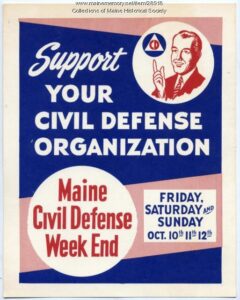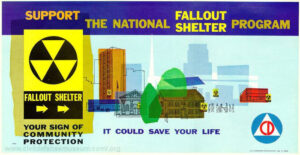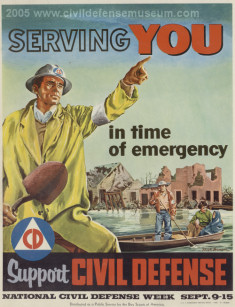If you were a child in the 1950s or ‘60s, you likely remember the “duck and cover” drills that we all had to do in school. We were all made aware of the impending atomic bomb attack, so in addition to the fire drills, we had to either; get under our desks, or go out into the hallway and knee along the wall. You might also recall the Fallout Shelters with the three triangle Civil Defense signs where we were suppose to go in case of a attack. So what was the history of all this?
Like everything, much of history has been dictated by over reactions to current events, and the Civil Defense movement was, in a way, a big overreaction that ebbed and waned throughout the ‘50s and ‘60s. The Soviet Union exploded their first atomic bomb in August 1949, meaning that the United States was not the only country with such toys, and then the Korean War began. This all raised the concern that the Soviets could have designs on invading Europe or even the United States. So in December 1949, President Truman established the Federal Civil Defense Administration and the Congress passed the Federal Civil Defense Act of 1950. This set off the 1950s Civil Defense movement.
In February 1951, Cayuga County began to organize emergency defense units. Port Byron and Mentz were divided into 50 sections, each with a Civil Defense warden who was to make surveys and help educate the local residents as to how to respond during an emergency. To help them understand the dangers and what they could do about it, the local wardens were shown a film called “Pattern for Survival” and then made plans for the coming attack. Safety tips included such helpful hints as painting your house a light color, having a stash of sandbags, extra water and food, and first aid supplies on hand. Meanwhile, school nurse Mary Murray discussed the medical aspects of atomic warfare at a PTA meeting.

In general, a national emergency established. If you were a kid in school, you likely watched a film that featured Bert the Turtle, who showed you how to “Duck and Cover.” In this film, children were taught that all would be well if they were on constant alert, aware of their surroundings and knew where to, at any moment, Duck and Cover. So kids, when you see the flash, be sure to Duck and Cover!
At this moment in history, any bomb to be dropped had to be carried by a strategic bomber. So air watches stations were set up. (This was a repeat of what happened during the Second World War when towers on high points were set up and staffed around the county and nation.) Across the nation, over 19,400 look-outs were organized as part of the Ground Observation Corps. Ten towers were in Cayuga County, with the Port Byron station up on Stand Pipe Hill (where the water tower is today). In 1953 Walter Kerns was the local tower supervisor, and Bessie Green served as the chief observer. Walter urged all citizens to volunteer to take a shift watching for enemy planes as the towers were to be staffed 24-hours a day. I guess due to our location along the border that it was possible, that maybe, a Soviet bomber could make it all the way to Port Byron without being noticed. However, the Chronicle noted, the local population was slow to respond to the need. This was not a local problem as across the nation only 150,000 volunteers had come forward to fill the 500,000 open slots.
In 1954, all of New York’s civil defense centers went through mock bombing drills that used scenarios where five nuclear bombs were dropped around the state. Three bombs were to be dropped on the Big City and one each on Schenectady and Buffalo. The paper noted that; “The time and interest devoted by any man or woman to training in first aid and other allied phases of civil defense is actually a sound investment in their own future and that of their neighbors. A great army of ‘self-help, neighbor-help’ trained volunteers must be obtained if our state and nation are to survive the consequences of an atomic attack.”
In 1955 the county ran a test called Applejack. On June 15th, the Applejack, or the red alert, was to be sounded with a three-minute-long siren blast. All citizens were advised to stop what they were doing and seek cover, even those who were driving about. They were told to stop their car and find shelter. The all-clear would be when the Snowman, or three one-minute blasts, was sounded. (I am not making this up. It all sounds very top secret! “General, it is five seconds to Applejack! Applejack, Applejack, Applejack! GET DOWN!)
Things began to change in August 1957 when the Soviet Union tested the first Intercontinental Ballistic Missile, otherwise known as the ICBM. The era of the airplane delivery system was over and their was no need to man the local towers. However, as the danger was perhaps even move real, the school kept up with the duck and cover drills. In 1958 the school made a test on how long it took for kids to duck and cover, or to be sent home. The result, local authorities noted, could mean the “survival of many,” which was the purpose of Civil Defense.
As the 1950s came to a close, so did the locally based Civil Defense efforts. However, the fear of attack was still very real, so the schools kept up with the duck and cover drills in school. The Berlin Crisis of 1961, and especially the Cuba Missile Crisis of 1962, refocused the federal governments efforts onto Community Fallout Shelters. In short, the population demanded some action since missiles were only 90 miles from our shore. Sturdy government buildings and schools were signed as shelters and each was stocked with food, water, sanitation, medical needs for a 2 week stay. But at 700-calories-per-day ration, no one was going to be happy. By the end of the decade, the danger that the population felt in 1962 had passed and the focus on these shelters waned. The shelter stocking program ended in 1969, however the supplies stayed in place for years. In the 1970s the stocks were tested and it was found that the food, mostly biscuits, crackers and cereals had gone bad. Every so often, we hear about CD stores being found tucked away in a basement shelter.

And yet, as fun as it might be to look back on those days, it is never a bad idea to be prepared. Storms have caused more damage to infrastructure then any nuclear attack, and having a emergency plan and supplies is not a bad idea. Many of the ideas of the past can be applied to today. So APPLEJACK, APPLEJACK, APPLEJACK!
